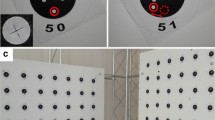Abstract
Good practice rules in the management of a movement analysis laboratory recommend that photogrammetric measurement errors are assessed, prior to every experimental session, using an ad hoc experiment referred to as a spot check. The paper proposes an inexpensive and easy to make spot check. The test uses a rigid rod carrying two markers and a target point taken on the line joining them and coinciding with the rod tip. The latter point is placed in a fixed and measured position in the laboratory frame and the markers are tracked while the rod is kept stationary and while it is manually made to rotate about the target point. Several target points are used within the measurement volume. The instantaneous errors with which the laboratory co-ordinates of the latter points are reconstructed are determined and submitted to statistical analysis. A normalisation procedure is illustrated that aims at making the test results independent from the geometry of the test object. The experimental and analytical methods underlying the proposed spot check were validated experimentally in two movement analysis laboratories using repeated tests. A rod, 1.5 m long, carrying four markers was used. In this way, several test-object geometries were tested. Results confirmed that the photogrammetric error could be divided into a zero-mean random and a systematic component. It was shown that the normalisation procedure was effective for the standard deviation of both error components when the two markers were located at a distance between them 1.5 times larger than the distance of their centroid from the tip of the rod. The systematic component bias could not be normalised, however a conservative value of it could be estimated. The two above-mentioned normalised standard deviations and the bias value can be taken as descriptors of the photogrammetric error of the specific measuring system tested. These parameters may also be used to assess the precision and the accuracy with which the laboratory position of a target point, defined relative to any specified marker cluster, may be reconstructed during movement analysis.
Similar content being viewed by others
References
Borghese, N. A., andFerrigno, G. (1990): ‘An algorithm for 3-D automatic movement detection by means of standard TV cameras’,IEEE Trans. Biomed. Eng.,37, pp. 1221–1225
Cappozzo, A., Leo, T., andMacellari, V. (1983): ‘The CoSTEL kinematic monitoring system: performance and use in human movement measurements’ inMatsui, H. andKobayashi, K. (Eds): ‘Biomechanics’ (Human Kinetics Publishers Inc, Champaign, Illinois), pp. 1067–1074
Cappozzo, A., andDella Croce, U. (1994): ‘PGD lexicon, Version 1.1′ in Measurement and data processing methodology in clinical movement analysis. CEC project CAMARC II (A-2002)/AIM, Internal Report
Cappozzo, A., Catani, F., Della Croce, U., andLeardini, A. (1995): ‘Position and orientation of bones during movement: anatomical frame definition and determination’,Clin. Biomech.,10, pp. 171–178
Cappozzo, A., Catani, F., Leardini, A., Benedetti, M. G., andDella Croce, U. (1996): ‘Position and orientation of bones during movement: experimental artefacts’,Clin. Biomech.,11, pp. 90–100
Cappozzo, A., Cappello, A., Della Croce, U., andPensalfini, F. (1997): ‘Surface-marker cluster design criteria for 3-D bone movement reconstruction’,IEEE Biomed. Eng.,44, pp. 1165–1174
Della Croce, U., Cappozzo, A., andKerrigan, D. C. (1999): ‘Pelvis and lower limb anatomical landmark calibration precision and its propagation to bone geometry and joint angles’,Med. Biol. Eng. Comput.,37, pp. 155–161
DeLuzio, K. J., Wyss, U. P., Jian Li andCostigan, P. A. (1993): ‘A procedure to validate three-dimensional motion assessment systems’,J. Biomech.,26, pp. 753–759
Ehara, Y., Fujimoto, H., Miyazaki, S., Tanaka, S. andYamamoto, S. (1995): ‘Comparison of the performance of 3D camera systems’,Gait & Posture,3, pp. 166–169
Furnée, H (1997): ‘Real-time motion capture systems’, inAllard, P., Cappozzo, A., Lundberg, A. andVaughan, C. L. (Eds): ‘Three-dimensional analysis of human locomotion’ (John Wiley & Sons, London), pp. 85–108
Gazzani, F. (1993): ‘Comparative assessment of two algorithms for calibrating stereophotogrammetric systems’,J. Biomech.,26, pp. 1449–1454
Holden, J. P., Orsini, J. A., Siegel, K. L., Kepple, T. M., Gerber, L. H., andStanhope, S. J. (1997): ‘Surface movement errors in shank kinematics and knee kinematics during gait’,Gait & Posture,5, pp. 217–227
Karlsson, D., andLundberg, A. (1994): ‘Accuracy estimation of kinematic data derived from bone anchored external markers’. ‘Proc. Third Int. Symp. 3-D Analysis of Human Movement’, July 5–8, 1994, Stockholm, Sweden, pp. 27–30
Lafortune, M. A., andLake, M. J. (1991): ‘Errors in 3d analysis of human movement’. Proc. Int. Symp. 3-D Analysis of Human Movement, July 28–31, 1991, Montreal, Quebec, Canada, pp. 55–56
Morris, J. R. W., andMacleod, A. (1990): ‘An investigation of the sources and characteristics of noise in a video-based kinematic measurement system’, in ‘Models, connections with experimental apparatus and relevant DSP techniques for functional movement analysis’. CEC project CAMARC II (A-2002)/AIM, Internal Report
Reinschmidt, C., Bogert, A. J., Van Den, Murphy, N., Lundberg, A. N., andNigg, B. M. (1997): ‘Tibiocalcaneal motion during running-measured with external and bone markers’,Clin. Biomech. 12, pp. 8–16
Samuelson, B. (1987): ‘A device for the three dimensional registration of human movement’,J. Ergonomics,30, pp. 1655–1670
Woltring, H. (1990): ‘Model and measurement errorinflunce in data processing’ inBerme, N. andCappozzo, A. (Eds): ‘Biomechanics of human movement-applications in rehabilitation, sports and ergonomics’, (Bertec Corporation, Worthington, Ohio, USA), pp. 203–237
Author information
Authors and Affiliations
Corresponding author
Rights and permissions
About this article
Cite this article
Croce, U.D., Cappozzo, A. A spot check for estimating stereophotogrammetric errors. Med. Biol. Eng. Comput. 38, 260–266 (2000). https://doi.org/10.1007/BF02347045
Received:
Accepted:
Issue Date:
DOI: https://doi.org/10.1007/BF02347045




